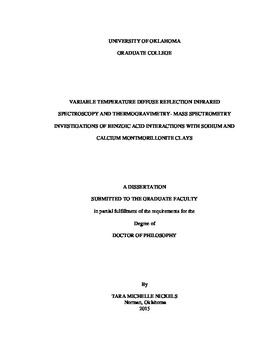| dc.contributor.advisor | White, Robert | |
| dc.contributor.author | Nickels, Tara | |
| dc.date.accessioned | 2015-05-11T14:41:39Z | |
| dc.date.available | 2015-05-11T14:41:39Z | |
| dc.date.issued | 2015-05-08 | |
| dc.identifier.uri | https://hdl.handle.net/11244/14606 | |
| dc.description.abstract | Molecular interactions between benzoic acid and cations and water contained within montmorillonite clay interlayer spaces and processes involved in thermal desorption of benzoic acid from sodium and calcium montmorillonite clays are characterized by using variable temperature diffuse reflection infrared Fourier transform spectroscopy (VT-DRIFTS) and thermogravimetry-mass spectrometry (TG-MS). The availability of high stability Fourier transform infrared interferometers make it possible to conduct experiments designed to identify subtle sample structure changes resulting from external perturbations. In particular, infrared spectrum measurements obtained while heating samples can be used to associate specific structure changes with incremental additions of thermal energy. By using sample perturbation and difference spectroscopy, infrared spectral changes resulting from removal of interlayer water are associated with changes in local benzoic acid environments. Additionally, desorption of benzoic acid is identified and subtle changes in molecular vibrations are detected and employed to characterize specific benzoic acid adsorption sites. Difference spectra features can be correlated with changes in specific molecular vibrations that are characteristic of benzoic acid molecular orientation. Results suggest that the carboxylic acid functionality of benzoic acid interacts with interlayer cations through a bridging water molecule and that this interaction is affected by the nature of the cation present in the clay interlayer space. These interactions can also be disrupted by the presence of organic anions, in particular, benzoate. Abrupt changes in benzoic acid adsorption properties occur for both clay samples at about 125 oC. Results from thermogravimetric-mass spectrometric analyses of sodium and calcium montmorillonites containing adsorbed benzoic acid are used to characterize adsorption sites and elucidate thermal desorption processes. Desorption of interlayer water is affected by the presence of benzoic acid, which disrupts cation-water
interactions. Multiple benzoic acid desorption environments are indicated, which depend
on the clay interlayer cation. Benzoic acid desorption occurs at higher temperatures for
clays containing calcium ions compared to those containing sodium ions, presumably due
to stronger interactions between the adsorbate and calcium ions. Benzoic acid desorption
profiles, as well as the detection of decomposition products, suggest that benzoic acid persists on clays to temperatures as high as 550 ºC. Above 300 ºC, benzoic acid decomposes, yielding benzene and carbon dioxide. | en_US |
| dc.language | en_US | en_US |
| dc.subject | Montmorillonite | en_US |
| dc.subject | Infrared Spectroscopy | en_US |
| dc.subject | Thermogravimetry-Mass Spectrometry | en_US |
| dc.subject | Benzoic Acid | en_US |
| dc.title | VARIABLE TEMPERATURE DIFFUSE REFLECTION INFRARED SPECTROSCOPY AND THERMOGRAVIMETRY- MASS SPECTROMETRY INVESTIGATIONS OF BENZOIC ACID INTERACTIONS WITH SODIUM AND CALCIUM MONTMORILLONITE CLAYS | en_US |
| dc.contributor.committeeMember | Liu, Shaorong | |
| dc.contributor.committeeMember | Yip, Wai-Tak | |
| dc.contributor.committeeMember | Rice, Charles | |
| dc.contributor.committeeMember | Nanny, Mark | |
| dc.date.manuscript | 2015-05-06 | |
| dc.thesis.degree | Ph.D. | en_US |
| ou.group | College of Arts and Sciences::Department of Chemistry and Biochemistry | en_US |
